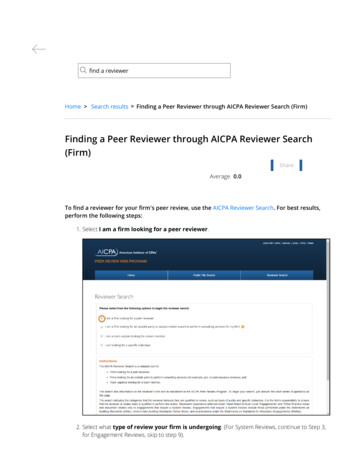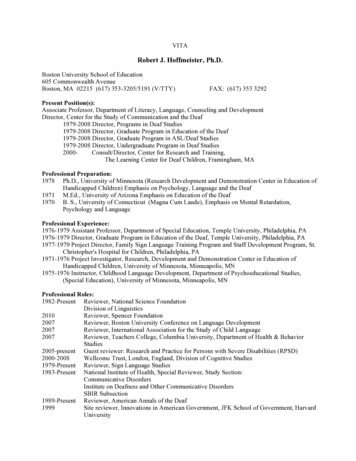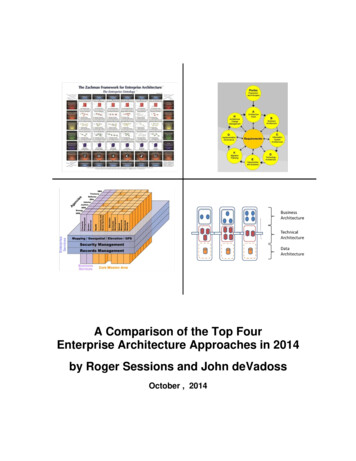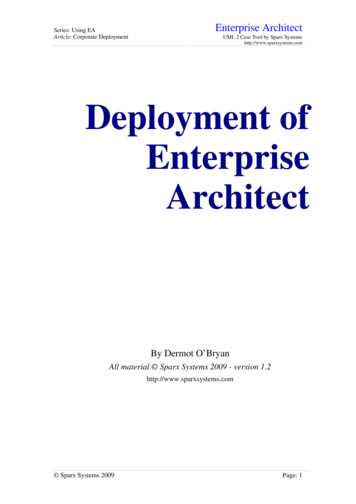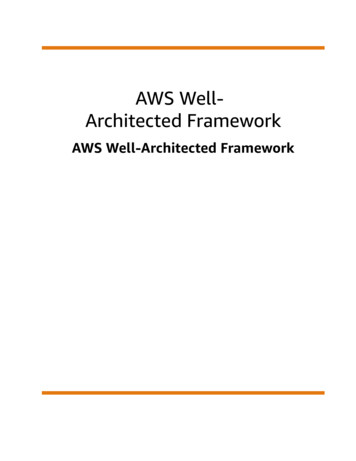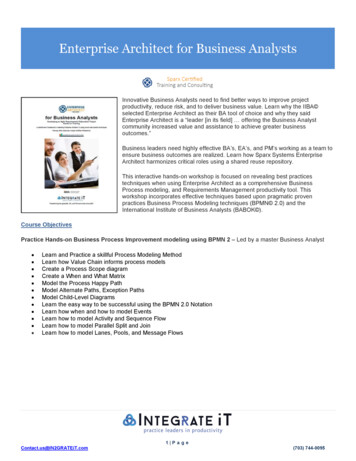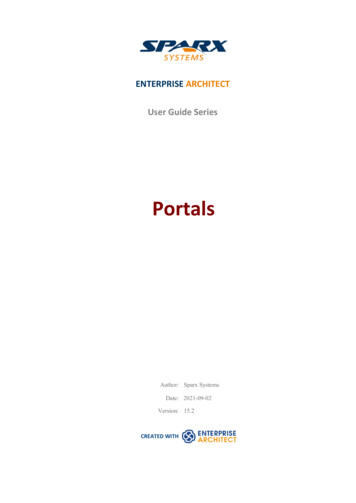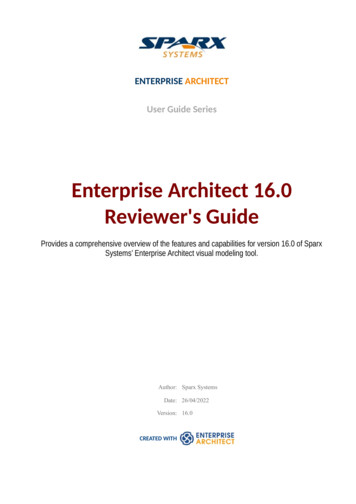
Transcription
ENTERPRISE ARCHITECTUser Guide SeriesEnterprise Architect 16.0Reviewer's GuideProvides a comprehensive overview of the features and capabilities for version 16.0 of SparxSystems’ Enterprise Architect visual modeling tool.Author: Sparx SystemsDate: 26/04/2022Version: 16.0CREATED WITH
Table of ContentsIntroduction.4Summary of Enterprise Architect Features.8Summary of Supported Standards.9Modeling Based on Open Standards.11Business Process Modeling and Simulation.12Decision Model and Notation (DMN).13Data Modeling and Database Engineering.14Requirements Management.16Systems Engineering.17Software Engineering.19Enterprise Architecture Frameworks.21Strategic Modeling.22Schema Modeling.24Spatial Information Modeling with GML and ArcGIS .26Test Management.27UI Design and Wireframes for Mobile Apps and Web Pages.28Cloud Services Modeling.29Productivity Boosters.31Perspectives.32Model Wizard and Process Guidance.33User Interface and Tools.34Distributed Teams and Collaboration.36Cloud sharing model repositories.37Pro Cloud Server Features.38Teams and Collaboration.40Change Management.42Traceability and Accountability.44Finding Elements and Searching Metadata.46Publishing.48Charts and Dashboards.50Project Management.51Model Driven Architecture.53Code Engineering.54Visualize, Debug and Profile Executing Code.56StateMachine Code Generation and Execution.57Model Simulation.58Connectivity and Integration with Other Tools.60Extending Enterprise Architect.63Automation Interface.65Enterprise Architect Editions.66About Sparx Systems.68Trademarks.70
Enterprise Architect 16.0 Reviewer's Guide(c) Sparx Systems 202226 April, 2022Page 3 of 72Created with Enterprise Architect
Enterprise Architect 16.0 Reviewer's Guide26 April, 2022IntroductionThis document provides a comprehensive overview of the capabilities of Sparx Systems Enterprise Architect at Release16. Each section focuses on a particular aspect of Enterprise Architect, providing an introduction to the purpose andbenefits of each capability.What is Enterprise Architect?Enterprise Architect is a visual platform for designing and constructing software systems, for business process modeling,and for more generalized modeling purposes.Enterprise Architect is based on the latest Unified Modeling Language (UML ) 2.5 specification. UML is a visuallanguage that is used to model a particular domain or system (either proposed or existing).Enterprise Architect is a progressive tool that covers all aspects of the development cycle, providing full traceability fromthe initial design phase through to deployment, maintenance, testing and change control.What differentiates Enterprise Architect from other UML tools?·Comprehensive UML 2.5-based modeling·Built-in Requirements Management·Extensive Project Management support, including resources, tasks, project calendar and metrics·Code engineering support for many languages out of the box·An integrated Visual Execution Analyzer to profile, debug and document executing applications; instantiate run-timemodel objects; and record sequence diagrams from a stack trace·Extensible modeling environment that can host user-defined profiles and technologies·Model Simulation: a range of options for simulating and testing models·Test Management built-in: Testpoint management, model-based test execution, test case specification and support forJUnit and NUnit·Web based accessibility including WebEA and Prolaborate·Flexible documentation options: HTML, PDF and DOCX report writers(c) Sparx Systems 2022Page 4 of 72Created with Enterprise Architect
Enterprise Architect 16.0 Reviewer's Guide26 April, 2022·Usability: Enterprise Architect makes it easy to get up and running quickly with UML·Speed: Enterprise Architect is a spectacularly fast performer·Scalability: Enterprise Architect can handle extremely large models and many concurrent users with ease·Price: Enterprise Architect is priced to outfit the entire team, making collaboration and team development costeffectiveHow popular is Enterprise Architect now?With over 1 million effective users worldwide, Enterprise Architect has proven remarkably popular across a wide rangeof industries and is used by thousands of companies. From large, well-known, multi-national organizations to smallerindependent companies and consultants, Enterprise Architect has become the UML modeling tool of choice fordevelopers, consultants and analysts in over 150 countries.Sparx software is used in the development of many kinds of software systems in a wide range of industries, includingaerospace, automotive, banking and finance, defense, electrical engineering, medicine, research and academia, retail,transport and utilities. It is also used effectively for UML and business architecture training in many prominent colleges,training companies and universities around the world. Actual implementations range from single users to companies with1000s of installations globally, involving teams working on large, distributed projects.What benefits does Enterprise Architect provide?Model and Manage Complex InformationEnterprise Architect helps individuals, groups and large organizations model and manage complex information. Oftenthis relates to software development and IT system design and deployment, but it can also relate to business analysis andbusiness process modeling. Enterprise Architect integrates and connects a wide range of structural and behavioralinformation, helping to build a coherent and verifiable architectural model, either what-is or what-will-be. Tools tomanage versions, track differences, audit changes and enforce security help control project development and enforcecompliance with standards.Model, Manage and Trace RequirementsCapture requirements using Enterprise Architect's built in Requirements Management, which supports full traceabilityfrom the base requirements through the design, build and deployment stages.Use impact analysis to trace any proposed changes from the source requirements through their design andimplementation, ensuring that you build the 'right' change into the system.Integrate Teams and Share a Vision(c) Sparx Systems 2022Page 5 of 72Created with Enterprise Architect
Enterprise Architect 16.0 Reviewer's Guide26 April, 2022A scalable, easily deployed, multi-user environment, Enterprise Architect integrates team members from all sections andall phases of a product’s (or system's) development and maintenance life-cycle, providing significant benefits from builtin collaboration and inherent information sharing. It provides a single repository for business analysts, softwarearchitects, developers, project managers, testers, and roll-out and support staff. It provides a 'unified' view of a complexsystem having many view points and many possible subsystems. Shared models can be accessed easily and securely byremote team members with Enterprise Architect's Cloud Server.Design and Build Diverse Systems using UMLUML 2.5, an open standard, provides a rich language for describing, documenting and designing software, business andIT systems in general. Enterprise Architect allows you to leverage the full expressive power of UML 2.5 to model, designand build diverse systems in an open and well understood manner. You can generate code, database structures,documentation and metrics, transform models, and specify behavior and structure as the basis for contractual agreements.Visualize, Inspect and Understand Complex SoftwareSoftware is complex and can often be hard to understand. Use Enterprise Architect to reverse engineer a wide variety ofsource code to understand static structure. To complete the picture, use the unique built-in profiling and debugging toolsat run-time to capture and visualize executing software. Create run-time instances of model elements and invokemethods using the built in Object Workbench. Integrate existing data models by reverse engineering database schema fora wide range of systems.Use Full Life-Cycle Modeling and Project ManagementCapture and track information about model elements that are important to success. For example: Testing, ProjectManagement and Maintenance details. Use this information to drive and track product development and delivery.(c) Sparx Systems 2022Page 6 of 72Created with Enterprise Architect
Enterprise Architect 16.0 Reviewer's Guide26 April, 2022Share and Re-Use Information Across ToolsEnterprise Architect supports a number of mechanisms for exporting and importing models using industry standard XMI.This allows modelers to use information created in other tools, to copy information between Enterprise Architect modelsand even to write and use custom tools that take XMI directly as input. Enterprise Architect can also be used as an OpenServices for Lifecycle Collaboration (OSLC) Provider, allowing other tools to identify and access modeled Requirementsvia a unique URL.Create Platform Independent Models using Model Driven ArchitectureModel Driven Architecture (MDA) is an open standard designed to facilitate rapid application development in a platformindependent manner. Models can be built at a high level of abstraction and, with MDA based tools, transformed intomodels and code targeting a specific platform or domain. Enterprise Architect has a rich set of tools built-in to supportMDA.(c) Sparx Systems 2022Page 7 of 72Created with Enterprise Architect
Enterprise Architect 16.0 Reviewer's Guide26 April, 2022Summary of Enterprise Architect FeaturesEnterprise Architect enables you to:·Model complex information, software and hardware systems using UML-compliant notation·Specify, model, manage and trace requirements to deployed solutions·Leverage industry-standard enterprise architecture frameworks·Generate and reverse engineer code in 10 programming languages·Model databases, generate DDL scripts, and reverse engineer database schema via ODBC·Manage, track and control change using Baseline model merge and auditing capabilities·Centralize enterprise-wide documentation of processes and information systems·Model dependencies between elements, system dynamics and state·Model Class hierarchies, deployment, components and implementation details·Record project issues, tasks and system glossary·Assign resources to model elements and track effort expended against required effort·Connect to shared database repositories using MS SQL Server, MySQL, Oracle and more·Share models via the Pro Cloud Server, WebEA, Sparx Systems Prolaborate or the Reusable Asset Service (RAS)·Exchange models from other tools using the XMI format·Produce detailed and quality documentation in PDF, HTML, DOCX and RTF formats·Manage Version Control through XMI using TFS, SCC, CVS and Subversion configurations·Migrate changes across a distributed environment using Controlled XMI Packages·Use UML Profiles to create custom extensions for domain-specific modeling·Save and load complete diagrams as UML patterns·Analyze and trace relationships between elements using the tabular Relationship Matrix·Script and automate common tasks using the Automation Interface and Model Scripts·Perform model-to-model transformations using Model Driven Architecture (MDA)·Create and share dynamic views of model elements and diagram sets using Model Views·Create Mind Maps, Business Process Models, Data Flow diagrams and Wireframes for mobile apps·Generate executable business logic from DMN business rules·Generate BPEL scripts automatically from business process models in BPMN notation·Visualize executing applications using the Visual Execution Analyzer·Transform behavioral models into executable source code both for software and for hardware description languages(HDLs) such as Verilog, VHDL, and SystemC·Simulate models, including Activity models, business process models, DMN models and SysML parametric models·Model and generate XML schema (XSD) and WSDL; Debug XSLT; Edit and Validate XML, XSD*Available features vary across editions. See (c) Sparx Systems 2022Page 8 of 72Created with Enterprise Architect
Enterprise Architect 16.0 Reviewer's Guide26 April, 2022Summary of Supported StandardsEnterprise Architect supports a range of open industry standards for designing and modeling software and businesssystems. The core standards supported are:·UML 2.5·BPMN 2.0·DMN ·ArchiMate 3.0·SysML 1.5·SysPhS 1.1·MARTE 1.2 ·BPEL·SoaML ·SPEM ·WSDL·XSD·DDS ·ArcGIS ·IFML ·CMMN ·Geography Markup Language (GML)·ODM , OWL and RDF·BMM 1.3·VDML 1.0·AWS, Google & Azure icon librariesEnterprise Architect also supports industry Frameworks such as:·Zachman Framework ·TOGAF (including FEAF)·UAF - UPDM framework that supports DoDAF, MODAF, FACE and NAF·Service-Oriented Modeling Framework (SOMF )Enterprise Architect supports Frameworks supplied by industry bodies:·GeoSciML·NIEM Enterprise Architect supports XML Service Oriented Architectures:·Service Oriented Architecture Modeling Language (SoaML)·Service-Oriented Modeling Framework (SOMF 2.1)·Web Services Description Language (WSDL 1.1)·National Information Exchange Modeling (NIEM) 5.0(c) Sparx Systems 2022Page 9 of 72Created with Enterprise Architect
Enterprise Architect 16.0 Reviewer's Guide26 April, 2022This includes round trip engineering of WSDL and XSD, which are used to facilitate BPEL generation.(c) Sparx Systems 2022Page 10 of 72Created with Enterprise Architect
Enterprise Architect 16.0 Reviewer's Guide26 April, 2022Modeling Based on Open StandardsAs a contributing member of the Object Management Group, Sparx Systems understands the importance of openstandards to communicate effectively to a wide range of stakeholders. To this end, Enterprise Architect helps you to:·Visualize systems using the latest UML 2.5 notation·Document and describe business processes with BPMN 2.0·Model and simulate systems engineering projects with SysML 1.5·Leverage numerous other open modeling standards – all in the one modeling environment!UML, BPMN and SysMLEnterprise Architect supports all UML 2.5 models and diagrams. You can model business processes, web sites, userinterfaces, networks, hardware configurations, messages and many other aspects of your development.In brief, Enterprise Architect:·Was the first UML tool to introduce comprehensive UML 2 support in April 2004·Continues to refine and update UML 2.5 support·Supports all 14 diagram types from UML 2.5In addition to UML, Enterprise Architect supports the latest Business Process Model and Notation (BPMN) and SystemsModeling Language (SysML) specifications. Enterprise modeling notations are also supported out-of-the-box, includingTOGAF, ArchiMate 3.1, UAF and DMN.Enterprise Architect supports numerous other diagram types that extend core UML diagrams for strategic modeling, mindmapping, formal requirements specifications, data-flow diagrams, user interface prototyping and domain-specificmodeling. The tool also provides alternative views that make editing the core UML diagrams more intuitive andeffective. One example is the State Table editor, which renders a standard UML StateMachine diagram as an editablelogic table.(c) Sparx Systems 2022Page 11 of 72Created with Enterprise Architect
Enterprise Architect 16.0 Reviewer's Guide26 April, 2022Business Process Modeling and SimulationThere are numerous approaches to business process modeling (BPM) used in conjunction with other modeling languages.In particular, Activity diagrams, Object diagrams and custom Profiles provide a wealth of modeling possibilities for BPManalysts to use. Enterprise Architect complements business process modeling via the underlying UML 2.5 languagepalette with custom analysis, requirements management and process management elements, along with extensivesimulation options.The BPMN profileOne popular notation among business analysts is the Business Process Model and Notation (BPMN). This notationspecifically targets the business modeling community and is mapped to UML through a BPMN Profile. EnterpriseArchitect provides built-in support of the latest BPMN 2.0 profile.BPMN 2.0 models are simulated using Enterprise Architect's built-in simulation engine. This allows you to dynamicallyexamine process flows, validate the model and collect timing and resource information on proposed or legacy processeswith a view to business process improvement.BPSim – Business Process Simulation and execution engineThe BPSim specification facilitates configuration and assignment of resources to activities or tasks, raising events,decision making and other real-world capabilities. The BPSim execution engine integrates with BPMN models defined inEnterprise Architect, providing the capability to run and store results from multiple simulations and to performcomparisons across each configuration's result set. Analysts and business strategists therefore gain unprecedentedflexibility in assigning operating information to a model and then assessing the quality of a solution based on informationreturned from the Simulation engine.BPEL generationEnterprise Architect generates Business Process Execution Language (BPEL) scripts from BPMN models. GeneratedBPEL scripts can then be executed using a third-party execution engine. Specific model validation rules help to ensurethat models generate valid BPEL code.(c) Sparx Systems 2022Page 12 of 72Created with Enterprise Architect
Enterprise Architect 16.0 Reviewer's Guide26 April, 2022Decision Model and Notation (DMN)Enterprise Architect includes extensive and highly effective support for the Decision Modeling Notation standard,providing modelers with tightly integrated features that support rule based decision modeling in a standards-compliantmanner, allowing for various simulations, as well as the generation of code that can be integrated into applications thatrequire evaluation of these rules.DMN Diagrams and ExpressionsDMN models consist of a visual grammar that allows decisions and business rules to be documented in a way that makesthem readable by both business and technical audiences, thus ensuring that decisions and rules are not misinterpreted.Decision Model notation provides a language for evaluating the logic of decisions - Friendly Enough ExpressionLanguage (FEEL). Using FEEL expressions in Decision Tables, you can define the logic for assessing the outcome ofyour business process.DMN SimulationAfter creating a Decision Model there are features for firstly validating the model, then simulating the model to returnresults of the decision process being modeled. The simulation includes standard run/step/debug options for steppingthrough the logic of the model. This includes features for defining data-sets used for running variations on the corevariables set in the model. The simulation results are displayed on the diagram, as well as by highlighting the active rulesset in the DMN expression.DMN Model Code GenerationAs well as simulating the DMN model, Enterprise Architect also supports the generation of code that can be integratedinto larger applications that require evaluation of those rules. This includes generation to Java/JavaScript/C /C#.Integration with BPMNEnterprise Architect provides interaction between BPMN diagrams and DMN models. Using a broader business-processBPMN simulation you can call a simulation of the DMN model.(c) Sparx Systems 2022Page 13 of 72Created with Enterprise Architect
Enterprise Architect 16.0 Reviewer's Guide26 April, 2022Data Modeling and Database EngineeringEnterprise Architect has extensive support for the data modeling discipline, ranging from the representation ofinformation in a conceptual model right down to the generation of database objects. Whether you are generating databaseobjects from the UML model or reverse engineering a legacy DBMS into a model for analysis, the tool features will savetime and valuable project resources.Enterprise Architect's Database engineering features support the top 10 most popular DBMSs, including model patternsused as starters for modeling each of these DBMSs.Data modelingWhen designing databases Enterprise Architect’s built-in Data Modeling profiles extend the UML to provide intuitiverepresentations of database concepts. Supported notations include:·IDEF1X·Information Engineering·UML DDL·Entity-Relationship (ER) notationThese extensions model database tables, columns keys, triggers, constraints, procedures and other aspects of relationaldatabase schemas.MDA TransformsWhen laying out your data model in conceptual and logical models, Enterprise Architect also supports MDA Transformsfor generating your Logical model (Platform Independent Model) to a Physical model (DBMS Specific Model).Database BuilderEnterprise Architect's Database Builder tool, which extends these data modeling features, can be used to create andmaintain physical data models and can connect to a running DBMS, supporting direct interaction with the live databaseto import the model, compare the updated model with the DBMS, and generate alterations directly from withinEnterprise Architect, providing comprehensive syncing between the model and the database.When implementing or maintaining databases, leverage Enterprise Architect's Database Builder to:·Quickly visualize your database schema with DBMS-specific model patterns and diagrams·Create tables, columns, primary keys, foreign keys, views and stored procedures(c) Sparx Systems 2022Page 14 of 72Created with Enterprise Architect
Enterprise Architect 16.0 Reviewer's Guide26 April, 2022·Define indexes, sequences, functions and triggers·Generate DDL and Alter DDL statements for all or part of your schema·Selectively update your live database from Generated DDL statements·Import an entire database schema via ODBC, or selectively update your physical model·Connect to and query your databases from within the model environmentThe Database Builder is designed to maintain updates across development, testing and production environments.(c) Sparx Systems 2022Page 15 of 72Created with Enterprise Architect
Enterprise Architect 16.0 Reviewer's Guide26 April, 2022Requirements ManagementGathering requirements is typically the first step in developing a solution, be it a software application or a businessprocess. Requirements are essentially ‘what the system needs to do’. Enterprise Architect’s built-in requirementsmanagement features help you to:·Define an organized and hierarchical formal requirements model·Clearly differentiate requirement types, such as functional and non-functional requirements·Link and trace system requirements to analysis and design elements and implementation artifacts·Search on requirements and perform impact analysis with respect to requirement changes·Generate custom reports or a complete requirements specification directly from the model·Create custom attributes or properties appropriate to your organization or project·Relate formal requirement elements directly to Use Case scenario steps, connecting early analysis artifacts tosubsequent system developmentEnterprise Architect is distinguished among UML tools by its built-in Requirements Management capabilities. Being ableto create requirements directly in the model resolves a number of traditional development issues such as traceability,interdisciplinary team divisions, integration with change and configuration management systems.You can readily connect your Requirements model with downstream processes, external artifacts such as files or otherresources, and technical documentation including architecture and implementation models.Specification ManagerBusiness analysts will be especially productive with Enterprise Architect's Specification Manager – a document-basedinterface for rapid entry of requirements into the model repository. A key feature of the Specification Manager is thespeed and ease with which you can create, filter and review a large number of elements from one point, withoutnecessarily developing or examining complex detail on each element.Structured Use Case ScenariosUse Case scenarios capture vital analysis information using natural language. Enterprise Architect's Structured Scenarioeditor lets you use this information to drive downstream development and maximize traceability across the developmentlife-cycle. From structured scenarios, you can generate Test Cases, Activity diagrams and other UML behavior diagrams.You can even reverse engineer existing process diagrams into structured, textual specifications to produce documentationdeliverables.(c) Sparx Systems 2022Page 16 of 72Created with Enterprise Architect
Enterprise Architect 16.0 Reviewer's Guide26 April, 2022Systems EngineeringIntegrating many high-end features for systems engineers, the Ultimate and Unified Editions of Enterprise Architectprovide SysML modeling, parametric model simulation, Real Time Embedded Systems modeling using MARTE,executable code generation, and model-to-code transformations for Hardware Description Language
Enterprise Architect 16.0 Reviewer's Guide 26 April, 2022 A scalable, easily deployed, multi-user environment, Enterprise Architect integrates team members from all sections and all phases of a product's (or system's) development and maintenance life-cycle, providing significant benefits from built-
